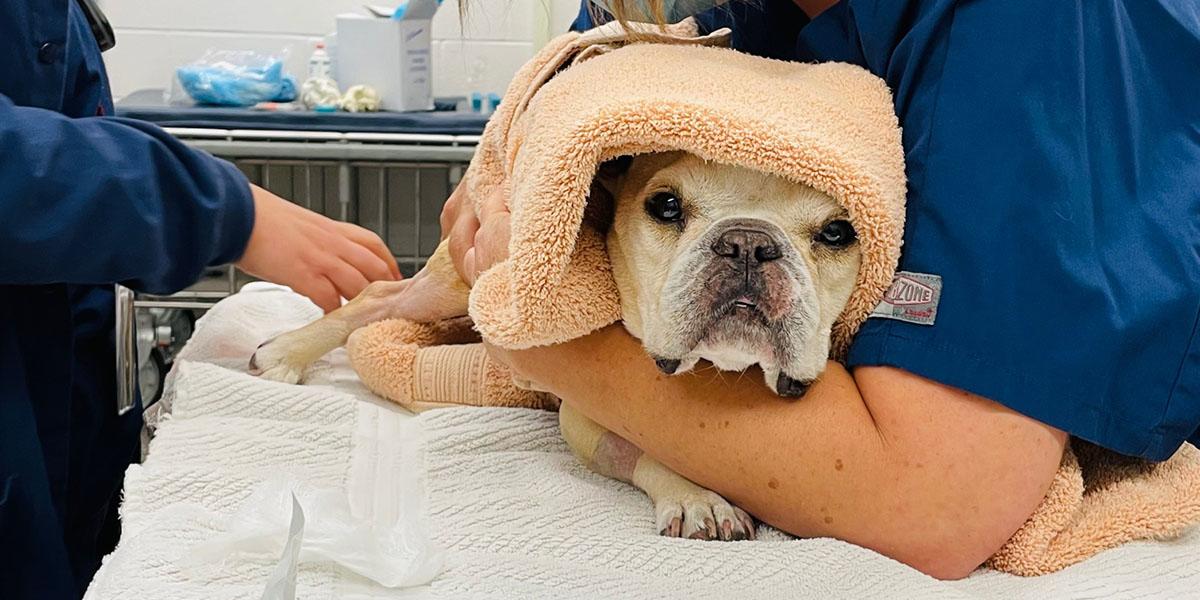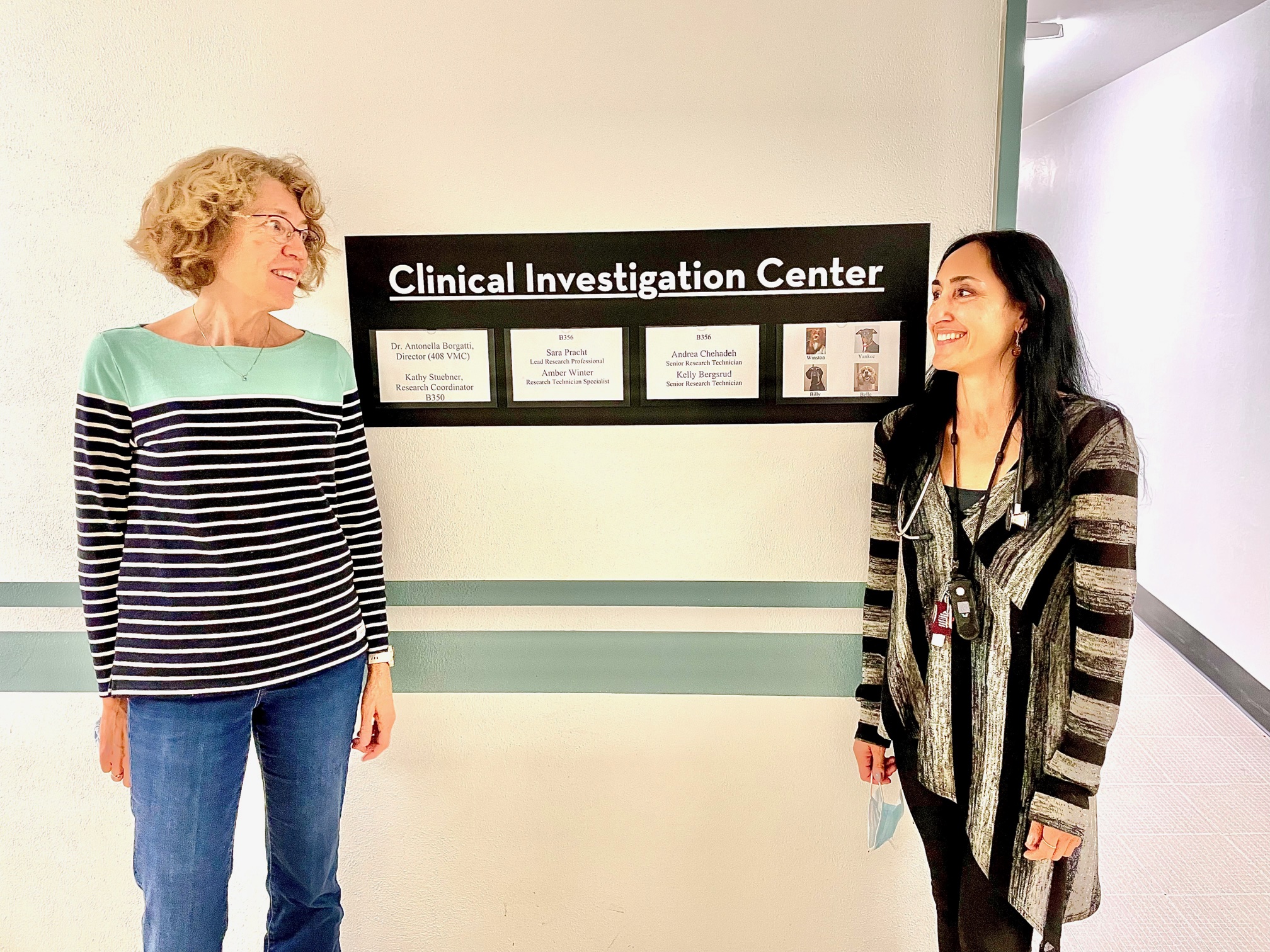Expanding toward the future
With more than $500K in new funding from the Office of the Vice President for Research, the Clinical Investigation Center is poised to grow capacity for clinical trials

With more than $500K in new funding from the Office of the Vice President for Research, the Clinical Investigation Center is poised to grow capacity for clinical trials
Research study technicians prep Bouchon, a French bulldog visiting from California, for anesthesia during a brain tumor study. Photo by Mike Oakes.
Recently, longtime College of Veterinary Medicine (CVM) Professor Timothy O’Brien walked by the surgery area of the Clinical Investigation Center (CIC) and was transported back in time. The space on the third floor of the Veterinary Medical Center is a hub for modern research but hasn’t seen a significant upgrade since “The Jetsons” was on television.
“I was having flashbacks to my fourth year in vet school,” O’Brien says. “That was 43 years ago. An update to the facility is definitely needed.”
Someone else noticed, too. The Office of the Vice President for Research (OVPR) in June announced it had awarded CIC Director Antonella Borgatti, DVM, MS, DACVIM, DECVIM-CA, more than $263,000 for her proposal to upgrade the CIC as part of the OVPR’s 2021 Research Infrastructure Investment Program Awards. That funding was matched by the College of Veterinary Medicine—a prerequisite to be considered—for a total of $526,700 in funds earmarked for the project.
The unique St. Paul campus tool that is the CIC facilitates the design and execution of studies to develop new drugs, devices, procedures, and treatments—at the intersection of preclinical, translational, and clinical research across a number of disciplines. Work done through the CIC has led to critical new drugs for animals and has been instrumental in paving the way for human clinical trials.
The center was born more than a decade ago out of the need to coordinate research efforts across the College, according to Research Manager Kathy Stuebner, whose first job was to identify who was doing research that the veterinary clinic wasn’t aware of in order to bring them into compliance.
“There wasn’t a lot of awareness for the myriad projects going on,” Stuebner says.
Since those early days, the center has done much toward its stated vision to become the “premier veterinary research center for clinical trials in the United States.” But despite propelling crucial medical advancements benefitting both animals and humans, and well-coordinated, multidisciplinary collaborations, there were pain points.
For example, the process to extract data from medical records has worked great for clinicians but was not ideal for researchers.
“Within those electronic medical records, there is a wealth of info which is set up well for patients in-clinic,” Borgatti says. “But not for quantifying or mining data to draw scientific conclusions.”

Essentially, the data existed but was inaccessible to researchers prior to this new funding. Now, the influx will cover a collaboration between the CIC and Health Sciences Technology to build a platform with which researchers can submit queries and see results of that previously unavailable data in seconds.
The center also plans to develop its first biobank for samples of various animal diseases that can be made available to researchers across departments. Modeled after a human biobank at the Masonic Cancer Center, the CIC version will begin with a collection of hematologic malignancies—the most common types of cancers in both animals and humans.
That gives CVM researchers and frequent collaborators at the cancer center access to a wealth of animal tumor types—providing new reach that positions the CIC as a critical facility at the intersection of animal and human health.
The award also will contribute to much-needed new equipment and renovations. That includes a new centrifuge, a portable anesthesia machine, and new lift tables to accommodate all sizes of animals, among other implements.
“The funding is a step toward achieving our vision of continuous growth in terms of equipment, in terms of what we can offer,” Borgatti says. “I do have a vision, and it will take time to get to that. This is definitely a step in the direction.”
I do have a vision, and it will take time to get to that. This is definitely a step in the direction.
Antonella Borgatti
“The funding is a step toward achieving our vision of continuous growth in terms of equipment, in terms of what we can offer,” Borgatti says. “I do have a vision, and it will take time to get to that. This is definitely a step in the direction.”
New digs aside, people remain the beating heart of the Clinical Investigation Center—the skilled technicians, administrative pros, and regulatory experts that guide clinicians and researchers through the nuance of collaborative trials. It’s those people who connect with patients and their owners—make them comfortable and keep them informed—in the furtherance of critical research.
“I’m still friends with Sara to this day,” says Diane Sacksteder, whose rottweilers Atlas, Luna, and Mercury have taken part in stem cell and orthopedic trials, about longtime CIC research study specialist Sara Pracht. “I would call Sara when Atlas was sick and I thought he was dying—and she would calmly reassure me using her expertise.
“I had a great experience. I really enjoyed the trials because everybody was so nice.”
The OVPR funding helps drive the center into the future, where its critical value will be brought to bear in more—and more advanced—trials. The new equipment, the biobank, the streamlined data extraction, the people—all of it—means more resources, more efficiency, and the ability to accommodate more projects.
“We already provide a great, high-quality service,” Borgatti says. “We would just like to do it on a much larger scale. The more efficient we are, the more projects we can accommodate. And the more tools we have to improve and expand our services, the more we can continue to develop.”
Borgatti’s was one of 10 University projects to receive a 2021 infrastructure award, which the OVPR says is “designed to facilitate interdisciplinary partnerships and strengthen the University’s research infrastructure.”
To learn more about current trials at the Clinical Investigation Center, click here.